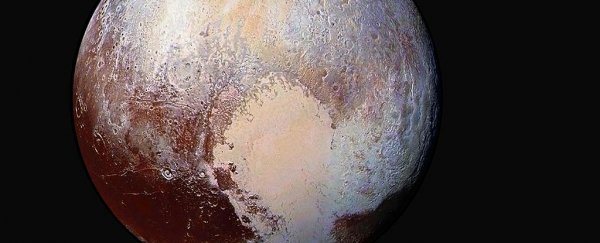The most recognizable feature on Pluto is its "heart," a relatively bright valentine-shaped area known as Tombaugh Regio.
How that heart got started is one of the dwarf planet's deepest mysteries – but now researchers say they've come up with the most likely scenario, involving a primordial collision with a planetary body that was a little more than 400 miles wide.
The scientific term for what happened, according to a study published today in Nature Astronomy, is "splat."
Astronomers from the University of Bern in Switzerland and the University of Arizona looked for computer simulations that produced dynamical results similar to what's seen in data from NASA's New Horizons probe.
They found a set of simulations that made for a close match, but also ran counter to previous suggestions that Pluto harbors a deep subsurface ocean. They said their scenario doesn't depend on the existence of a deep ocean – which could lead scientists to rewrite the history of Pluto's geological evolution.

University of Arizona astronomer Adeene Denton, one of the study's co-authors, said the formation of the heart "provides a critical window into the earliest periods of Pluto's history."
"By expanding our investigation to include more unusual formation scenarios, we've learned some totally new possibilities for Pluto's evolution," Denton said in a news release. Similar scenarios could apply to other objects in the Kuiper Belt, the ring of icy worlds on the edge of our solar system.
The study focuses on the western half of the heart, a roughly 1,000-mile-wide, teardrop-shaped region called Sputnik Planitia. That region contains an assortment of ices and is roughly 2.5 miles lower in elevation than the rest of Pluto. It's clearly the result of a massive impact.
"While the vast majority of Pluto's surface consists of methane ice and its derivatives, covering a water-ice crust, the Planitia is predominantly filled with nitrogen ice which most likely accumulated quickly after the impact due to the lower altitude," said study lead author Harry Ballantyne, a research associate at the University of Bern.
The eastern half of the heart is covered by a similar but much thinner layer of nitrogen ice. The origins of that part of Tombaugh Regio are still unclear, but it's probably related to the processes that shaped Sputnik Planitia.
Ballantyne and his colleagues ran a wide assortment of computer simulations for the ancient impact. Those simulations reflected a range of sizes and compositions for the impacting body, at different velocities and angles of approach.
The best fit for Sputnik Planitia's shape involved a 400-mile-wide object, composed of 15% rock, coming in at an angle of 30 degrees and hitting Pluto at a relatively low velocity.
Based on those parameters, the object would have plowed through Pluto's surface with a splat. The resulting shape wouldn't look like your typical impact crater. Instead, it would look like a bright, icy teardrop, with the rocky core of the impacting body ending up at the tail of the teardrop.
"Pluto's core is so cold that the rocks remained very hard and did not melt despite the heat of the impact, and thanks to the angle of impact and the low velocity, the core of the impactor did not sink into Pluto's core, but remained intact as a splat on it," Ballantyne explained.
Previous scenarios for Sputnik Planitia's origin relied on the presence of a deep ocean beneath Pluto's surface to explain why the impact region hasn't drifted toward Pluto's nearest pole over time.
But the researchers behind the newly published study found that the best matches in their simulations called for an ocean measuring no more than 30 miles in depth.
"If the influence of ammonia proves negligible, Pluto might not possess a subsurface ocean at all, in accordance with our nominal case," they wrote.
The researchers say they'll continue their work to model Pluto's geological history – and how those models could apply to other Kuiper Belt objects as well.
Meanwhile, the New Horizons spacecraft is continuing its journey through the solar system's far reaches, nearly nine years after its Pluto flyby. Mission scientists recently reported detecting higher than expected levels of interplanetary dust, which suggests there may be more to the Kuiper Belt than they thought.
They're hoping to identify yet another icy world that the spacecraft can observe up close in the late 2020s or the 2030s.
This article was originally published by Universe Today. Read the original article.
